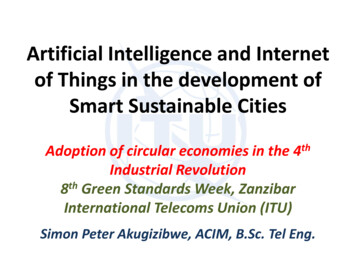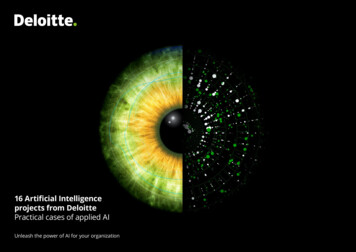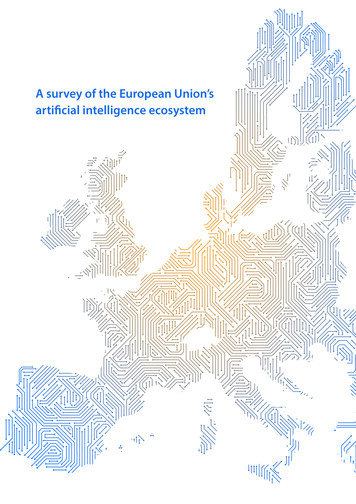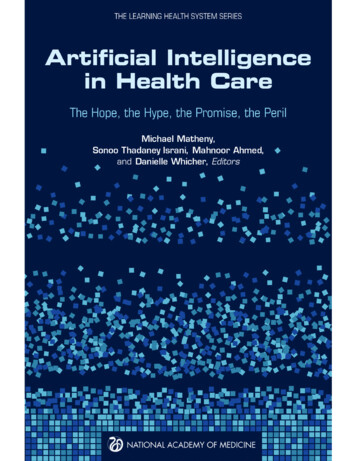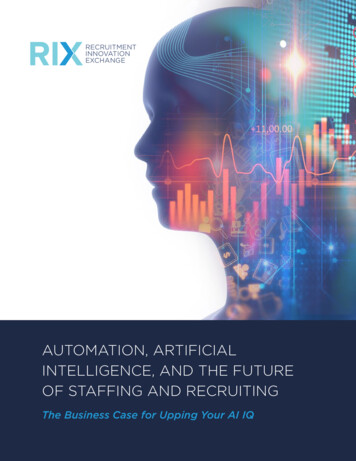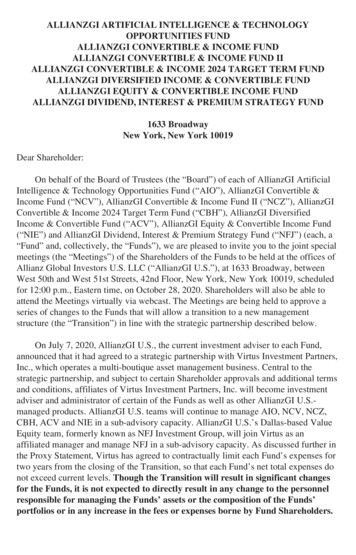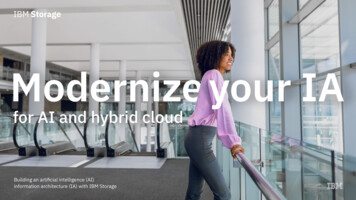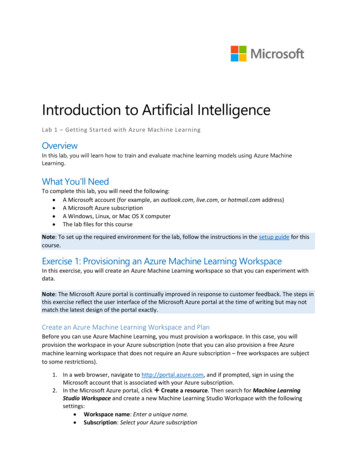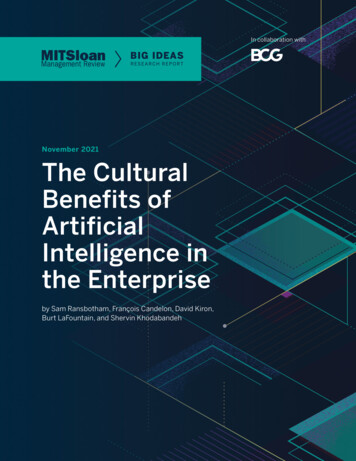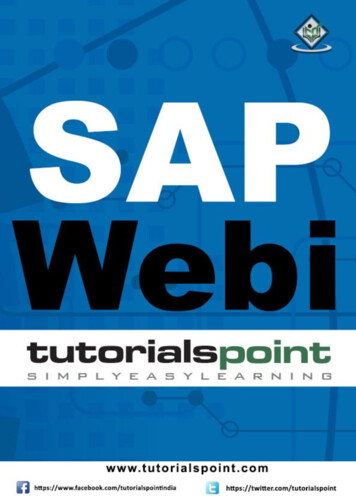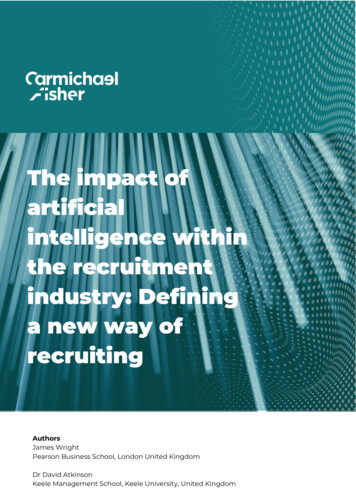
Transcription
The impact ofartificialintelligence withinthe recruitmentindustry: Defininga new way ofrecruitingAuthorsJames WrightPearson Business School, London United KingdomDr David AtkinsonKeele Management School, Keele University, United Kingdom
The impact of artificial intelligence within the recruitmentindustry: Defining a new way of recruitingAuthorsJames WrightPearson Business School, LondonUnited KingdomDr David AtkinsonKeele Management School, Keele UniversityUnited KingdomAbstractThis paper set out to consider artificial intelligence (AI) and the impact its growing influence ishaving within the recruitment industry. This research considered how AI is influencing employersand candidates, specifically throughout the initial stages of the recruitment process. With limitedacademic research conducted to date, AI has been accepted, by practising recruitmentspecialists, as being “game-changing for HR” (May, 2016, p.6). The overarching aim of thisresearch was to make recommendations on how recruitment processes could be changed, forthe better, in recognition of the introduction of AI technology.Technology has always held an influence within the recruitment scene, reducing costs anddelivering increased effectiveness in recruiting candidates (Okolie, 2017, Singh, 2003). However,the US Department of Labor suggested recruitment, as it stands, is only 16% effective (ClearFit,n.d.). If this is the case, the introduction of AI provides the opportunity to achieve significantimprovements. According to Bullhorn (2018), these early improvements are likely to effect thesourcing and screening of candidates, the initial stages of the recruitment process.Due to the lack of academic literature regarding AI’s influence on the recruitment industry, anintegrative literature review was conducted to develop new perspectives on the topic (Saunderset al., 2016). As a result both scholarly literature and professional sources were used. To developa structured analysis of these sources, thematic analysis was used (Braun et al., 2006). Thesethemes were taken from arguments made in the literature surrounding the impact and influencethat AI could have in recruitment. The themes of ‘risks and limitations’, ‘bias and inclusion’ and‘technicalities and opportunities’ guided a framework for primary research to be conducted.In order to assess the potential impact that AI may have on recruitment processes, three forms ofresearch were undertaken. Semi structured interviews were conducted with nine experts invarying fields surrounding recruitment and AI. An online survey with 132 respondents providedinsight into a candidates pre-existing perceptions of recruitment processes. Finally, anobservation of a round-table event was conducted in order to analyse the key themes, thoughtsand concerns of experts that exist currently within the field of AI in HR.This paper concludes with the suggestion of a newly formed recruitment process. This processintegrates significant structural and technological change in recruitment but enables HR teamsto maximise the efficiency and effectiveness of their talent acquisition. As a result, thePage 1 of 39
standardised process of recruiting for roles will need to be flipped, from trial and error, to a ‘testfor success’ model.KeywordsArtificial Intelligence, Recruitment, Human Resources, Technology, Employers, CandidatesPage 2 of 39
IntroductionThis paper looks at Artificial Intelligence and the growing influence it is set to play in the therecruitment industry. Specifically considering how the introduction of Artificial Intelligence willinfluence employers and candidates for roles throughout the recruitment process. Thisconsiders the initial job posting through to candidate search and finally interviewing andevaluation of candidates. The purpose of this is to establish the recommended approach forrecruiters, both in-house and consultancies, to make hires following the inevitable changes inthe industry that will be seen. To answer this question, interviews have been conducted withexperts in the industry, contrasting these with the opinions of employees and job seekers andfinally analysing the trends of an observation. These primary research findings have beencontrasted with the existing literature on the topic. As a result this paper concludes that there isa new recommended process of recruitment to be followed. This process will require significantstructural and technological change in recruitment processes but will enable teams to maximisethe efficiency and effectiveness of their talent acquisition strategies. As a result the standardisedprocess of recruiting for roles will be flipped, from a trial and error process, to a test for successmodel.Page 3 of 39
The Problem & OpportunityThe recruitment industry has a significant issue, the traditional hiring process where a CV andinterviews are used have been found to be ineffective. A study by the US Department of Laborand Gallup suggested this process is only 16% effective in finding the right candidate for a role(ClearFit, n.d.). To counter this concern, a large number of companies have incorporated preemployment assessments which ask candidates a set list of questions. These are reliable(consistent, even when repeated) and valid (relevant to job performance) however they areincredibly time consuming for applicants and result in lower completion rates due to the effortof completing them (HireVue, 2018). As a result companies are losing out on some of the toptalent in the market. This explains why Talent Acquisition has been highlighted as the third mostimportant challenge companies face with 81% of the 10,000 respondents suggesting it was‘important’ or ‘very important’ (Schwartz et al, 2017). The same report by Schwartz et al (2017)suggests that recruitment stands at the early stages of a technology based revolution. This isbacked up by LinkedIn’s research on the Global Recruitment Trends (2017) which suggests thelargest challenge for recruiters is the 'competition for talent’ (57%).Technology has continuously enabled recruiters to process more candidates and deliver ahigher quality, more cost effective service to both job seekers and employers alike (Okolie, 2017& Singh, 2003) and AI is expected to be no different (Tandon, 2017 & Raviprolu, 2017). Theacknowledgement that AI is “game-changing for HR” (May, 2016, p.6) suggests it could haveboth positive and negative implications. The last shift in the recruitment industry was thedevelopment of the world wide web and opened up the ability of global e-recruitmentstrategies increasing applications for roles universally (Okolie et al, 2017). Companies beganaccessing a wide range of data points from more personal sources such as social media whichwas not always well received by candidates who wanted to keep their work and personal liveseparate (Quast, 2012).The concept of AI has been present for decades however only more recently the concept hasbecome a reality. The likes of IBM’s Watson have previously shown the public the potential of AIand its cognitive capabilities rivalling that of a humans (IBM, 2016). Technologies surrounding AIhave now reached the phase of high-speed development, impacting numerous industries withthe ability to support and potentially replace a number of both manual and cognitive focusedroles (Campolo et al, 2017). They enable firms to remove the tasks that are repetitive, tediousand prone to error due to ambiguity (Singh, 2017). None of this would be possible without data,between 2013 and 2015 more data was produced than the rest of human race combined (Marr,2015).AI has many sub-categories, Machine Learning (ML) being one, this process takes sets ofinformation and draws conclusions from patterns of previous behaviour. More recently ML hasbeen superseded by Deep Learning which offers untrained insight therefore spotting patternswithout necessarily receiving guidance from a human programmer (LeCun et al, 2015). Thisprovides the opportunity to discover new and exciting options and methods in a wide variety oftasks and decision making processes. This explains why Matt Fischer, CTO at Bullhorn suggests anumber of repetitive, and now more notably, non-repetitive tasks within the recruitment industrysuch as sourcing and screening candidates are predicted to be automated in the next few years(Bullhorn, 2018).A survey conducted by the HRPA (2016) found that 84% of HR firms thought AI was a useful toolwithin recruitment, the same report also concluded that HR firms are either ‘not veryprepared’ (33%) or ‘not prepared at all’ (35%) for AI within their operations. This is a noteworthyconcern for recruitment companies looking to invest in this technology, as it is not only a largePage 4 of 39
investment financially, but it may have major negative consequences aligned to itsimplementation.Page 5 of 39
Literature ReviewIntroductionAt the time of writing, academic literature on the specific influence AI will have on therecruitment industry is very limited. This review will be integrative in order to develop newperspectives on the topic (Saunders et al, 2016). To widen the array of literature, both scholarlyliterature and professional sources have been used. This is firstly because AI is a topic that isincredibly fast moving and as a result caused scholarly literature to fall behind. Secondly thearea of HR is rarely covered by academics and thus better suited to professional reports.To develop a qualitative analysis of these sources thematic analysis was used. These themeswere taken from arguments made in the literature surrounding and the impact the influence thatAI could have in Recruitment, specifically on candidates and employers.These are: Risks and Limitations Bias and Inclusion Technicalities and OpportunitiesRisks and LimitationsRaviprolu (2017) directly considers the role of AI within Human Resources (HR) andacknowledges that there are a number of barriers to adoption at this stage, firstly AI requires alarge amount of data that is also accurate, these data sets are very complex to effectivelyunderstand the psychology of candidates. Yano (2017) highlights AI is nothing more than anempty box unless data is applied. Campolo et al (2017) argued that with increasingly protecteddata sets there are risks of companies using cheaper, non-representative, and therefore lessvalid, data sets to train AI programmes. Bafaro et al (2017) also explains that a ML programmight need to review years of succession data to actually understand success factors, and this isassuming that data is accurate. Wishkirchen et al (2017), whilst being a supporter of AI within therecruitment process does concede that even the most sophisticated AI technologies can makemistakes. GDPR is another data challenge that needs to be considered and with an estimated80% of recruitment companies not being complicit with the rules, it will heavily impact theindustry (Chaker, 2018). IBM (2016) have however commented that the benefits of AI outweighthe risks largely highlighted above. Raviprolu (2017) also suggests the capability of AI has notyet reached strong communication abilities. Tandon et al (2017) agrees with this concluding thatAI’s influence will not result in full automation of the process.Okolie et al (2017) considered E-Recruitment, the last technological shift in the recruitmentindustry. The paper notes that E-Recruitment had negative aspects such as impersonalising theprocess on both sides, in the initial stages it also discriminated against those who did not haveaccess to internet.Schwartz et al (2017) considered the important factors within Human Capital Management(HCM) and found ‘Robotics, Cognitive Computing and AI’ at the bottom of the pile (40%) withTalent Acquisition third highest (81%). The disconnect between recruitment and newtechnologies is because AI is still in the early stages of development within the HR industry, andthe workplace is now attempting to catch up with the technology available (Francis et al, 2017).Page 6 of 39
There has been the suggestion that AI could feasibly replicate the human decision makingprocess (Frey et al, 2013) however Parnas (2017) points out a program imitating humans is notthe best way for these technologies to operate as this may result programs that areuntrustworthy and dangerous.Bias and InclusionCampolo et al (2017) conducts a critical approach to analysis of AI’s impact socially as well aseconomically and explains ML programmes are using existing data points to make decisionscould result in transferring and entrenching cultural and gender based discrimination. Incontrast to this Wishkirchen et al (2017) suggests the use of AI within recruitment will remove allbias by focusing purely on facts rather than emotions and sympathies. Approximately 70% of HRand recruitment departments suggest technology is improving their hiring decisions (Randstad,2018). New hiring tools such as video analysis systems enable decisions based on fact ratherthan opinion to help further diversity and inclusion by eliminating unconscious human biases(Poitevin et al, 2017 & PwC, 2017). Bafaro et al (2017) explains that data analytics tools are thekey to enable better decision making and predictions about candidates.Florentine (2016) used an example of how discrimination could occur using an AI Algorithm. Ifan AI, machine learning algorithm found that Quarterbacks in American Football had a statisticalrelationship with high performance in sales roles based on data relating to mental skills, decisionmaking and leadership it can generate the unintended consequence of eliminating all femalesfrom the process because they cannot be in an American Football team. The source suggestssmaller nuances may not be spotted by humans.Technicalities and OpportunitiesKing et al (2017) delivers insight into the potential economic impact and the prominentcapabilities of AI technologies. King et al (2017) considers the impact of Deep Learning, citingobject recognition, natural language processing (NLP) and machine vision as key technologies.Not only are machines able to process data sets faster but they can spot patterns in large datasets that cannot be connected by humans. LeCun et al (2015) reaffirms the value of NLP inparticular as a core aspect of Deep Learning. Deep Learning consumes data in the environmentthat programmers expose it to and with big data readily available the process, it is acceleratingat a faster rate than ever before. Frey et al (2013) highlights the advancements in ‘AffectiveComputing’ theories, which incorporate human level social intelligence into the technology. Thisenables real-time social tasks such as negotiation, persuasion and care, explaining why over85% of respondents to a recent survey considering AI within recruitment believe thatassessment centres, interview scheduling, sourcing candidates and lastly on-boarding newemployees could all be automated (Pröhm et al, 2017). This is leading to recruitment firms andleadership radically changing their processes to accommodate for the acceleration in thecapabilities of AI (Chitkara et al, 2017 & CognitionX, 2017) to ultimately benefit from thecompetitive advantage seen from the first movers (Rao et al, 2017).Frey et al (2013) also states AI is “spreading to domains commonly defined as non-routine” (Freyet al, 2013, p.17). The paper also highlights two key categories of work, firstly the differentiationof cognitive and manual tasks, secondly the differentiation between routine and non-routineroles. Big data is now enabling programmes to reach non-routine, cognitive tasks. As a resultRaviprolu (2017) predicts that AI will save recruitment firms time and money by delivering moreaccurate analysis of candidates and company requirements through these new analysismethods.Page 7 of 39
Okolie et al (2017) stated employers had benefits including lower costs, more applicants andbetter candidate matching with candidates having an easier application process, with a widevariety of job opportunities and finally a greater response rate from the employer to receivefeedback. Poor hiring decisions are estimated to cost 1.6 million for every 1000 hires made(Randstad, 2018). Bullhorn (2018) suggest efficiency is one of two reasons for increasingautomated processes in recruitment. The second motivation is improving engagement withcandidates, they argue the main route to do this is through chatbot technologies. Depending onthe recruiter and their responsibilities, it is estimated they spend between 33% (de Lara et al,2018) to 60% (CognitionX, 2017) of their working day sourcing and screening candidates. Thisburden is set to be removed by AI (HRPA, 2017), as a result the cost of hiring candidates couldbe reduced by up to 71% and improve recruiters efficiency by up to three times (CognitionX,2017). Faliagka et al (2012) directly agrees, adding that AI will reduce the time required to fillvacancies as well as aiding the recruiter in ranking candidate suitability. Improving the candidateexperience is something a recruiter is tasked with but the current level of administrative tasks inthe industry stops them from doing this, AI is argued as the solution (May, 2016).Page 8 of 39
Conceptual FrameworkAs the structure to the literature review suggests, there are three key themes that have emergedbest categorised as Risks and Limitations, Bias and Inclusion and finally Technicalities andOpportunities. Bias and Inclusion as a topic, could potentially fit into either Risks and Limitationsor Technicalities and Opportunities. However this area in particular is a very contested area ofliterature, with an even balance of both positive and negative opinions hence it has beenseparated into another topic.The technicalities of Artificial Intelligence appears to be well documented through AI focusedacademic literature. As a result any primary research will have little consideration on how thetechnology works and rather focus on application, opportunity and value to the recruitmentprocess. The remaining categories will therefore be main areas of consideration in this researchdue to widespread disagreement of both academic and professional sources in these themes: Theme 1: Risk and Limitations Theme 2: Bias and Inclusion Theme 3: OpportunityIt is clear that the literature largely focuses on the employer experience over that of thecandidate. Thus this research will focus on developing findings that evenly consider both sidesof the process. As a result these three themes above may be built and expanded upon in theresearch.Page 9 of 39
Research Aims and ObjectivesAimThe aim of this research paper is to establish the impact that AI will have within the next fiveyears on the recruitment industry delivering a specific focus on how this technology willinfluence the experience of employers and candidates. As a result creating recommendationson a new process of recruitment.Objectives1. Provide insight into the influence Artificial Intelligence will have on the recruitment industry,furthering the limited academic research currently available.2. Investigate the impact of Artificial Intelligence on the employer and candidateindependently and establish the positive and negative effects for both parties.3. Interview industry experts from the fields of recruitment consultancy and ArtificialIntelligence to combine and contrast insights to deliver valid predictions on the impact andchange that will be seen through new processes developed by Artificial Intelligence.4. Using interviews, a candidate survey and an observation, obtain up-to-date and targetedresearch on the topic of AI and Recruitment, specifically considering Risk and Limitations,Bias and Inclusion, and Opportunity.5. Make recommendations that add value to recruiters considering the introduction of AItechnologies into their existing practices, enabling readers to make well foundedjudgements on the viability of using AI with
considers the initial job posting through to candidate search and finally interviewing and evaluation of candidates. The purpose of this is to establish the recommended approach for recruiters, both in-house and consultancies, to make hires following
